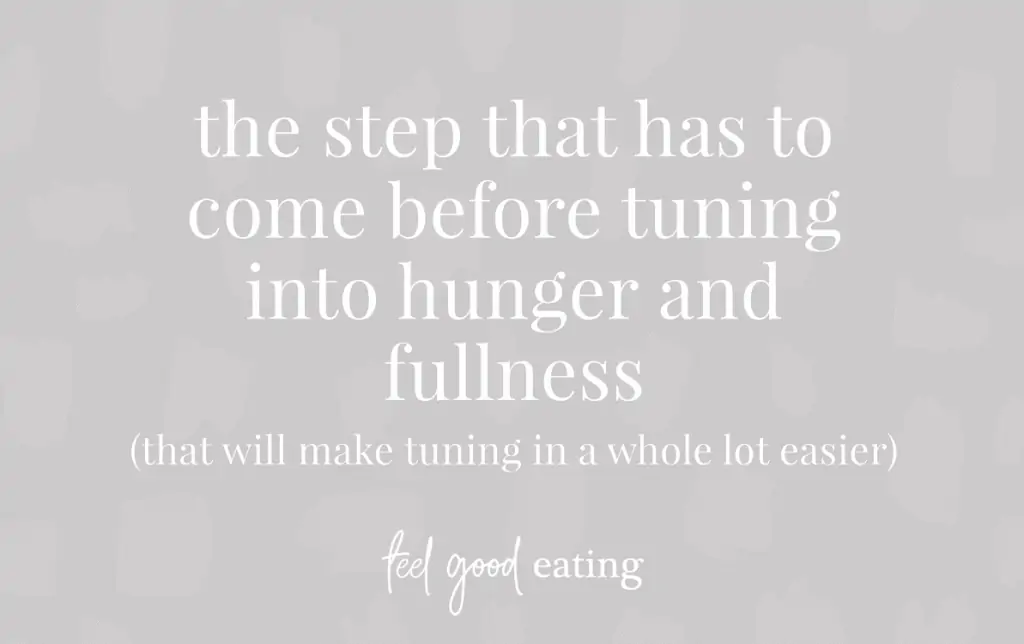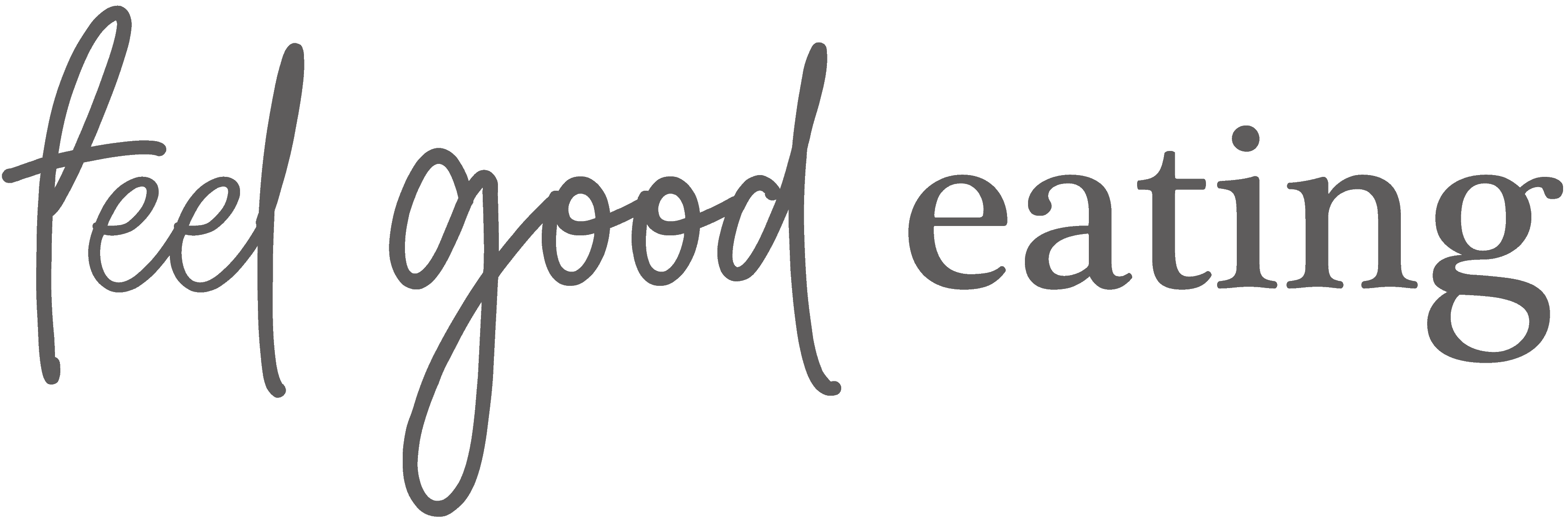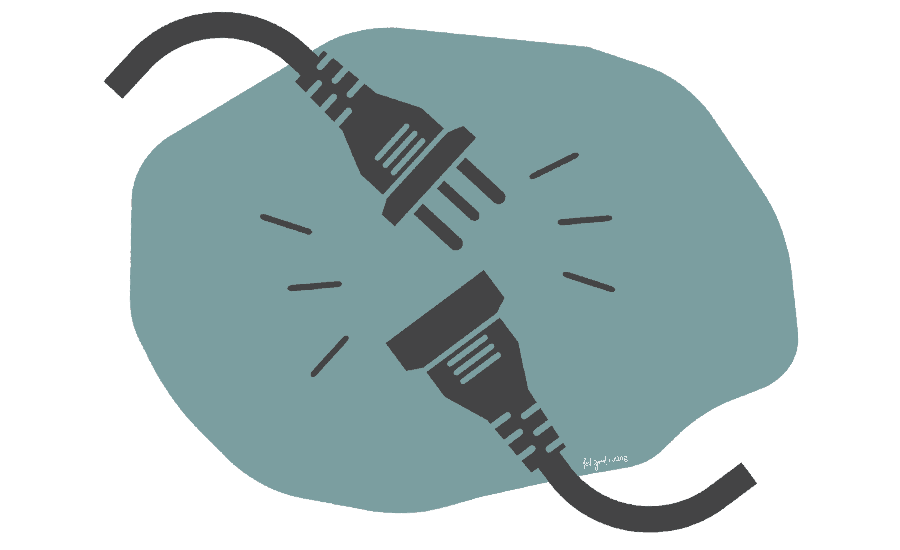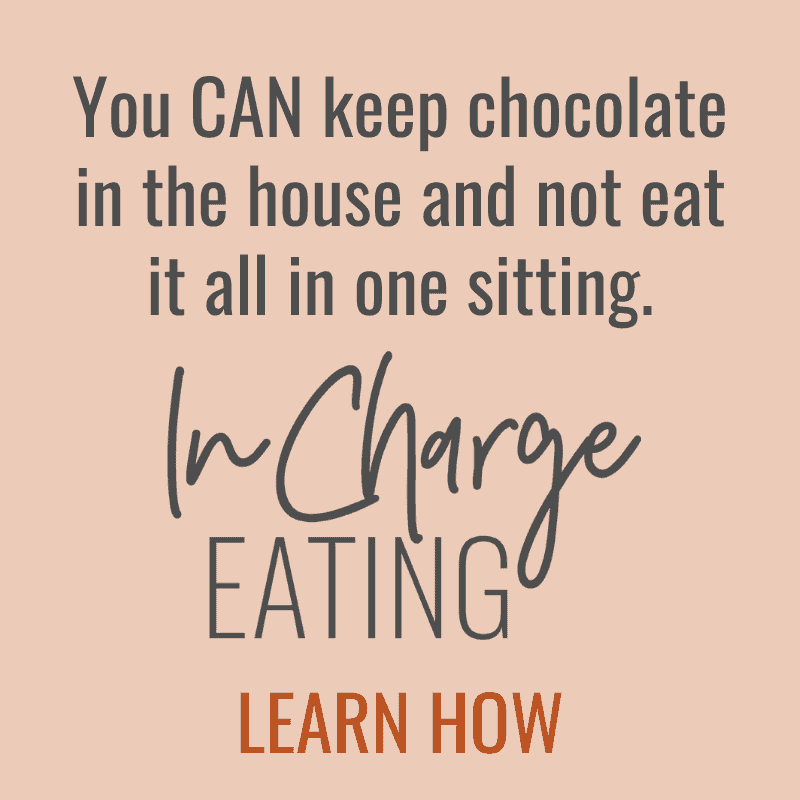To establish a more peaceful and easeful relationship with food and body, we just quit dieting and start tuning into our hunger and fullness, right?
If you have tried to listen to your hunger and fullness after having been on a diet, or maybe after having spent years trying to manage your weight, and you are finding you are not sure what your hunger and fullness feels like, then you know it is not that simple.
You are also not alone.
It is really common for people who have a history of dieting to find it a challenge to just start feeling their hunger and fullness cues AND trust them.
(Learn more about what being on a diet looks like)

why it is tricky to feel hunger and fullness to begin with
Being on a diet (whatever that looks like), means that we are making our decisions about the what, when, why and how much of eating based on rules that are external to our body.
We are deliberately NOT tuning into hunger and fullness.
And in fact, if we feel hungry, that is something we actively push past until the next time our diet or rule says we are allowed to eat.
And if we don’t feel full after eating, we ignore that too because our diet or rule says we have eaten our allocated amount of food for that meal or snack and that should be enough.
When we place more trust in external cues, it means that our trust in our internal cues erodes over time.
And all of the deliberate effort to tune out from our bodies internal cues means we lose our ability to pick up on them.
The erosion of trust goes both ways though. Our bodies respond to us ignoring hunger and fullness by firstly turning up the volume on them in the hopes that we pay attention. But if continually ignored, they will eventually turn them down or shut them off altogether. After all, why would our bodies waste energy and resources reaching out to us if we are essentially ghosting them!
In addition to this, the restriction that is the hallmark of all diets and the rebound eating that happens in response to that restriction (whether that is in the form of breaking the diet, or a ‘cheat day’, or a non-fasting day etc); leaves our bodies feeling like their food supply is constantly under threat. Given that food is life affirming, it makes a lot of sense that our bodies become more preoccupied in just getting us to eat rather than worrying about whether they are sending out reliable hunger and fullness cues.
So, it is a lot to ask that you simply ‘tune into hunger and fullness’ as the first step after you stop dieting.
how to make tuning into hunger and fullness easier
There is a step that has to come first before we attempt to do any tuning in that will go a long way to rebuilding that trust that has been broken. That step is:
Eating regularly.
As in, multiple meals and multiple snacks a day.
Every day.
Eating regularly is a way that you can demonstrate to your body that there will be no more interruptions to its food supply, and it can begin to trust you again.
When your body trusts this, your hunger and fullness signals will start to slowly come back online.
Eating regularly also sets a foundation upon which you can feel more confident that when your body sends out the message that it is hungry or full that those signals are reliable and need to be responded to.
You can expect to be able to feel when you are extremely hungry and extremely full to start with.
And from there you can build upon that foundation of regular eating, with your active practice of tuning into hunger and fullness, i.e. those classic intuitive eating or mindful eating practices, so that you can re-learn what your hunger and fullness truly feels like, along with how you experience the more subtle cues of hunger and fullness.
taking that first step of eating regularly
I want to offer a couple of suggestions that you might find helpful in approaching regular eating.
-
- I’ve talked about putting weight loss on the back burner in the past. It is also OK to put trying to listen to hunger and fullness on the back burner if you are in the early stages of moving away from diets or disordered eating. Take that pressure off yourself and just focus on making eating regularly happen every day.
- Eating regularly typically looks like having three meals and two to three snacks every day that are spaced out at regular intervals (every three-four hours) so that there aren’t big gaps between when your body receives food.
- If eating in this way is sounding diet-y or meal plan-y, again, know that you are not alone! Remember that this is the step that comes before tuning into hunger and fullness. Think of it more as the bridge that will move you away from the rigidity of diets and meal plans and towards attuned eating. It is the scaffolding we are constructing around your eating to build the foundations upon which you can become more attuned. And like all scaffolding, it eventually gets taken down once we know our building (or in this case our attunement) is rock solid.
- You will probably find that eating feels like a chore, your next meal or snack rolls around really quickly, you won’t feel like eating and/or you are thinking about food A LOT. All of this is really normal too and is temporary. See tip #1 about permission to drop the pressure and just focus on eating regularly.
- Eating multiple meals and snacks requires some thought and planning, so you might want to make a date with yourself to set yourself up with the best chance of success.
- Know that your body isn’t broken, it just needs time to heal and re-build trust. And know that you are not failing at adulting if you haven’t ‘got it together’ with your eating. Get mad at diet culture for pulling one over you and leading you to believe your body wasn’t meant to be trusted.
- It’s OK if all of this is feeling overwhelming, and it’s OK to reach out to get some support.


 Hi! My name is Nina.
I’m a Certified Intuitive Eating Counsellor taking the ‘diet’ out of Dietitian. I am here to help you reject diet culture, tune into your body’s own inner wisdom about how to truly nourish yourself and ultimately feel good eating™
Hi! My name is Nina.
I’m a Certified Intuitive Eating Counsellor taking the ‘diet’ out of Dietitian. I am here to help you reject diet culture, tune into your body’s own inner wisdom about how to truly nourish yourself and ultimately feel good eating™ 


well written! keep up the good work!
Thanks Amy!
Thanks Nina, I often talk to people about regular eating and hunger and fulness but this step back is really nice to understand.
Thanks so much for reading Lisa – nice to hear it resonated with you.